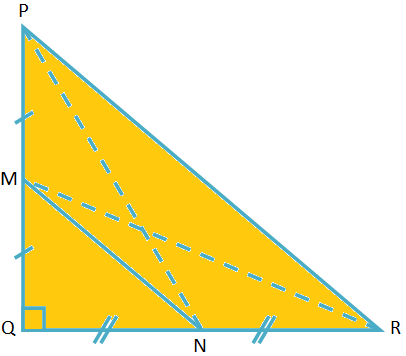Subscribe to our ▶️ YouTube channel 🔴 for the latest videos, updates, and tips.
Applying Pythagoras’ Theorem
Applying Pythagoras’ theorem we will prove the problem given below.
∆PQR is right-angle at Q. M and N are the midpoints of PQ and QR respectively. Prove that PN\(^{2}\) + RM\(^{2}\) = 5MN\(^{2}\).
Solution:
Given: In ∆PQR, ∠PQR = 90°.
PM = MQ and QN = NR
Therefore, PQ = 2MQ and QR = 2QN
To prove: PN\(^{2}\) + RM\(^{2}\) = 5MN\(^{2}\).
Proof:
|
Statement |
Reason |
|
1. ∆PQN, PQ\(^{2}\) + QN\(^{2}\) = PN\(^{2}\) ⟹ (2MQ)\(^{2}\) + QN\(^{2}\) = PN\(^{2}\) ⟹ 4MQ\(^{2}\) + QN\(^{2}\) = PN\(^{2}\) |
1. By Pythagoras’ theorem Given |
|
2. ∆RQM, MQ\(^{2}\) + QR\(^{2}\) = RM\(^{2}\) ⟹ MQ\(^{2}\) + (2QN)\(^{2}\) = RM\(^{2}\) ⟹ MQ\(^{2}\) + 4QN\(^{2}\) = RM\(^{2}\) |
2. By Pythagoras’ theorem Given |
|
3. 5MQ\(^{2}\) + 5QN\(^{2}\) = PN\(^{2}\) + RM\(^{2}\) ⟹ 5(MQ\(^{2}\) + QN\(^{2}\)) = PN\(^{2}\) + RM\(^{2}\) |
3. Adding statements 1 and 2. |
|
4. 5MN\(^{2}\) = PN\(^{2}\) + RM\(^{2}\) (Proved) |
4. Applying Pythagoras’ theorem in ∆QMN. |
From Converse of Pythagoras’ Theorem to HOME PAGE
Didn't find what you were looking for? Or want to know more information about Math Only Math. Use this Google Search to find what you need.



New! Comments
Have your say about what you just read! Leave me a comment in the box below. Ask a Question or Answer a Question.